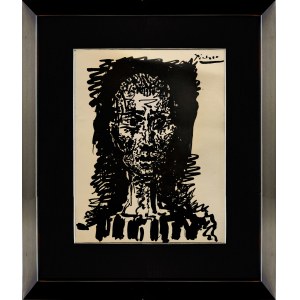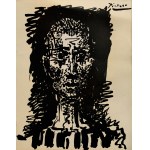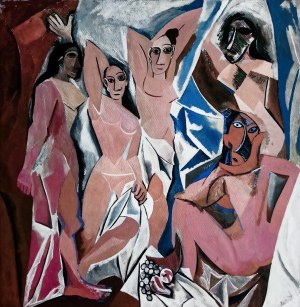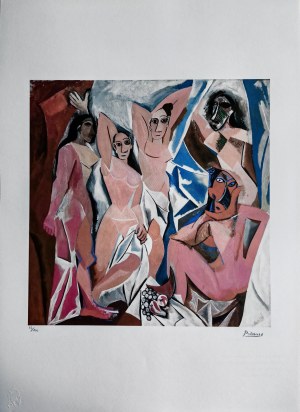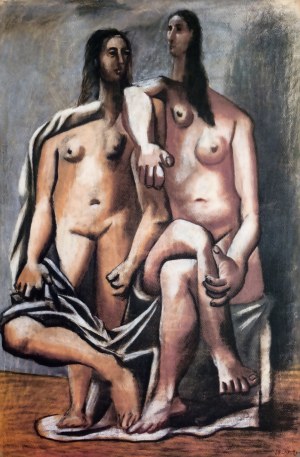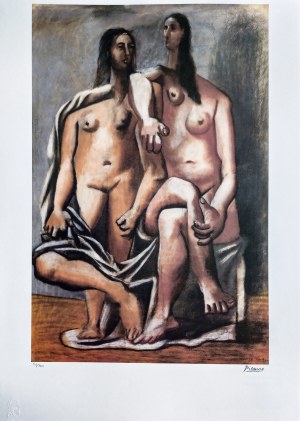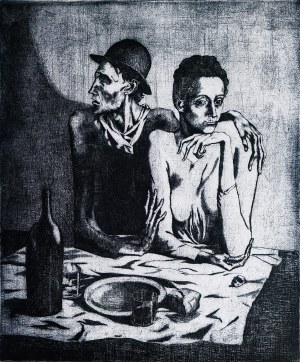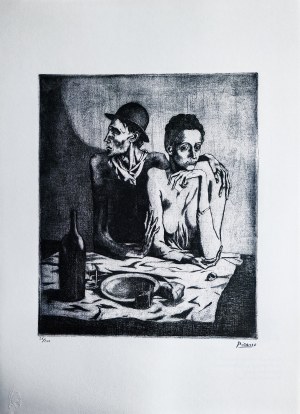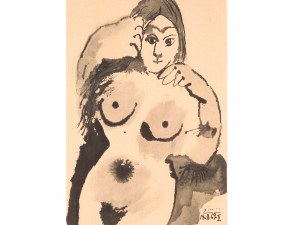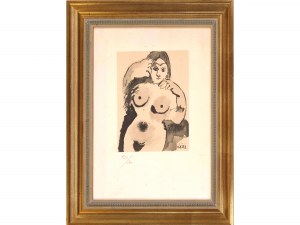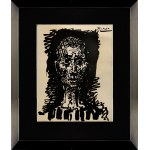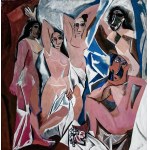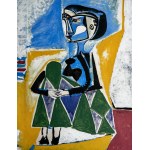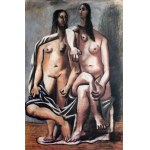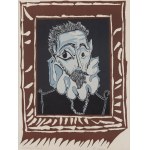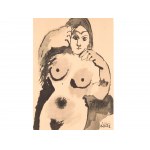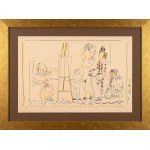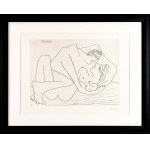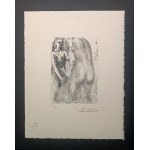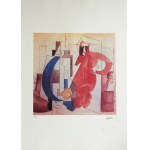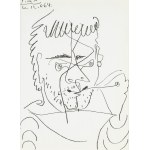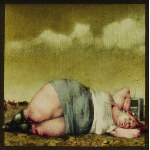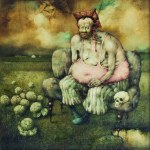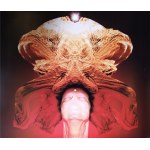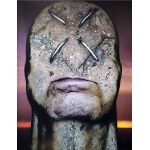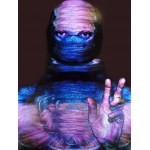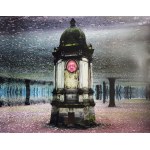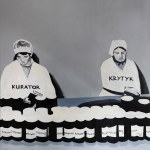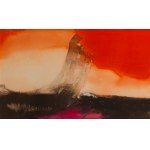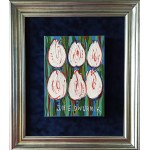Lithograph on paper
Dimensions in st. p-p: 27 x 21 cm, 39 x 33 cm (with frame)
Signed on the plate p.g.: 'Picasso'.
The lithograph was created in preparation for a Paris evening commemorating the tenth anniversary of the liberation of the Auschwitz concentration camp. Picasso's work accompanied concerts and lectures held on the left bank of the Seine on January 23, 1955. The lithograph, however, was more than an ephemeral commemorative print. As late as January it was reproduced in the international press; in Poland it was reprinted by "Trybuna Ludu"; Almost all of Picasso's prints from the 1950s were created at Studio Mourlot. The artist began working with the owner, Fernand Mourlot, in 1945, encouraged by the positive reviews of Henri Matisse and Georges Braque. Initially he perfected his craft under the wing of the publisher, then, from the late 1940s, commissioned him only for projects to be completed. The Mourlot studio enjoyed a great reputation in Paris and, from the 1930s onward, brought together a number of important artists, including: Miro, Chagall, Braque, Giacometti and Dubuffet.
"Prisoner's Head" is a unique work compared to other works coming out of the studio, as well as to Picasso's works of the period. It is primarily considered against the background of the anti-war paintings that the artist had been creating since the 1940s. Picasso was known for his uncompromising political views and his involvement in peace congresses and the communist movement. One of the most famous anecdotes about the painter concerns a conversation Picasso is said to have had in his studio with a German officer during the occupation. The soldier, looking at sketches documenting the creation of "Guernica" in 1937, was said to have asked: "Did you do that?" Picasso's answer was: "You did it."; The accusatory tone, however, is missing from most of Picasso's anti-war works. "Prisoner's Head" is a good example of this. The artist does not point out the culprits, but focuses on depicting the victim. He avoids overexpression and hyperbolization.; Picasso saw the Auschwitz camp during his trip to Poland in 1948. The artist, invited to the Congress of Intellectuals in Defense of Peace held in Breslau, went on a short trip after the official speeches. He visited Warsaw and Cracow, among other places. The final point of the visit was Auschwitz. Pierre Daix, who accompanied the Spanish artist, noted that Picasso was very moved and cried at Auschwitz. At the same time, it is difficult to find works in the artist's art that constitute a reckoning with the Holocaust. "Head of a Prisoner" is a unique example of this subject matter in Picasso's work.
Pablo Picasso (1881-1973) - Spanish painter, sculptor, printmaker and ceramicist, considered one of the most outstanding artists of the 20th century. He and Georges Braque are the creators of the painting trend known as Cubism. From an early age, Pablo revealed his talent for painting and art. He was first educated in Spain, then in Paris (1901-1922), where his work was greatly influenced by his encounter with the Post-Impressionists (including Henri de Toulouse-Lautrec, who had a strong influence on his pre-1901 work). Picasso's works from 1901-1904 are referred to as the Blue Period. These were works maintained in melancholic colors, depicting subjects and figures of poor people (Life, The Old Guitarist, Two Sisters, The Ironworker). His studio was located on La Boetie Street. From 1904, he lived in the Bateau-Lavoir at 13 Ravignan St. After this period, Picasso's work entered the pink period, including scenes of circus life (Girl on a Ball, Jugglers, Toilet, Harlequin Family). From 1907 Picasso, influenced by Paul Cézanne and Iberian and African art, began creative experiments with geometrization and simplification of form, which gave rise to Cubism (Virgins of Avignon, Portrait of Gertrude Stein). In the further period after his collaboration with Georges Brac, the principles of analytical, hermetic and synthetic cubism crystallized. The premiere of the stage work Parades to a libretto by Jean Cocteau, with music by Erik Satie and set design by Picasso, was considered a manifesto of Cubism. It was staged in 1917 by Sergei Diaghilev's "Russian Ballets." The following years were characterized by constant creative exploration. When the Spanish Civil War broke out, he took the Republican side, and in 1937, commissioned by the Republican government of Spain for 200,000 pesetas, he painted the famous Guernica, a painting exhibited in the Pavilion of Spain at the World Exhibition in Paris. He spent the period of World War II in Paris, joined the French Communist Party in 1944, and after the war became involved on the side of the leftist and peace movements. In 1946 he moved to the Côte d'Azur. In 1948 he settled in Vallauris. In 1948 Picasso came to Poland, participated in the World Congress of Intellectuals for Peace in Wroclaw, Poland, and visited Warsaw, where he donated his collection of ceramics, drawings and color prints to the National Museum. Signatory of the Stockholm Appeal in 1950. In 1950 he received the International Lenin Peace Prize (then called the Stalin Prize)[3]. In the 1940s he painted anti-war paintings (Massacre in Korea, War, Peace). Picasso's post-war period is very rich, diverse and defies classification. (Source: Desa Unicum)
Literature - cf. Picasso in Polish Collections, exhibition catalog at the National Museum in Warsaw, Dorota Folga-Januszewska, Warsaw 1995, p. 43 (ill.), cat. no. 57; - cf. Picasso in Poland, ed. Mieczyslaw Bibrowski, Krakow 1979, p. nlb. (ill.), cat. no. 35; - cf. Mieczyslaw Bibrowski, Comrade Picasso in Poland, "Polityka" 1966, no. 4, p. 6 (ill., as etching); - cf. "Trybuna Ludu", 28 I 1955 (ill.).
Recently viewed
Please log in to see lots list
Favourites
Please log in to see lots list



